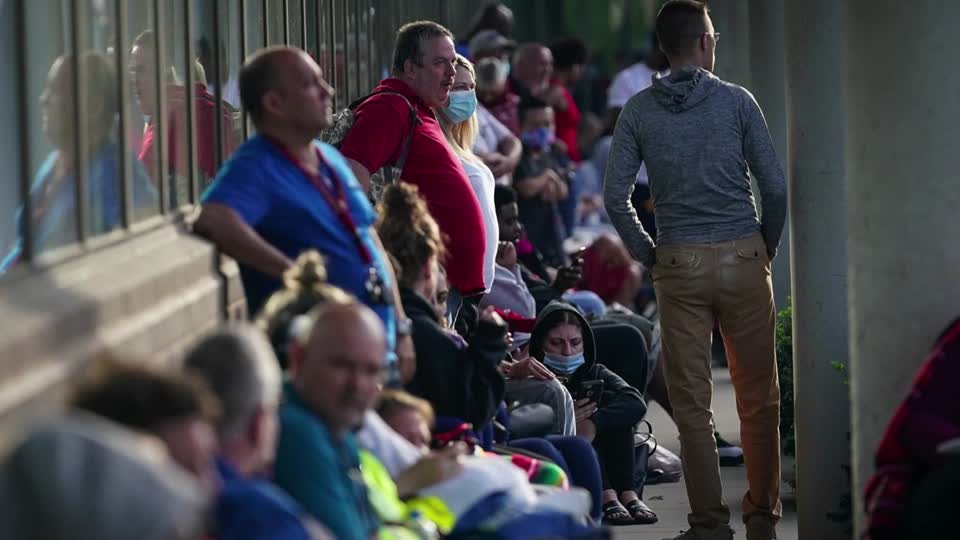What would Biden’s and Trump’s policies mean for unemployment?

A few minutes every morning is all you need.
Stay up to date on the world's Headlines and Human Stories. It's fun, it's factual, it's fluff-free.
With a new stimulus unlikely until after November’s presidential election, addressing US unemployment could be left to whoever occupies the White House in January.
Despite dropping from its astronomical heights reached in April 2020 as a result of the coronavirus pandemic, unemployment in the United States remains high, with millions of Americans out of work.
The latest figures from the Bureau of Labor Statistics show that some 7.9% of Americans remain unemployed as of September 2020, down from 14.7% in April.
Though joblessness has fallen, the economic recovery hailed by President Donald Trump as “leading the world” may be beginning to lag. Unemployment claims have begun to rise once more and the addition of new jobs to account for those millions lost as a result of the pandemic has also begun to slow down.
In the midst of all this, talks on additional economic stimulus are no closer to completion, with President Donald Trump himself taking a number of contradictory stances, at times signaling an end to negotiations only to then call for more stimulus than is being requested by Democrats.
With no further stimulus agreed by America’s politicians, it is likely that the economic recovery will fall apart into a protracted stagnation that will see unemployment remain in the millions.
The two presidential candidates vying for election in November both have radically different stances on the economy and its current recovery. Both present very different paths to resolving America’s current unemployment crisis, but both may have to contend with a virus that is still far from under control.
Coronavirus shock
Before the outbreak of the pandemic, President Donald Trump frequently boasted of his record on US unemployment figures, calling himself “the greatest jobs president that God ever created.”
While it is true that in December 2019, prior to the pandemic, US unemployment figures stood at 3.5%, a low last achieved in 1969, this record low was largely in line with a continued decline in unemployment since October 2009.
Unemployment was at 10% in October 2009 following the Great Recession but enjoyed what was essentially a continuous decline through to Trump’s presidency. This decline in unemployment was also quicker in Barack Obama’s presidency than in Trump’s.
Prior to the pandemic, in three years of his presidency, Trump had added 6.4 million additional jobs, compared to Obama’s seven million over a similar time frame.
When it arrived, the coronavirus pandemic delivered an unprecedented blow to the US economy. Unemployment rocketed up to a height of 14.7% in April, with millions of Americans left jobless and dependent on federally-supplemented unemployment benefits.
Some industries were hit even harder. In May, the unemployment rate for the leisure and hospitality industry reached a staggering 39.8%.
High levels of unemployment also came about faster than they did during the Great Recession. Unemployment in the first three months of the pandemic rose quicker than it did in two years of the Great Recession and also reached greater heights than the previous economic crisis.
Economic recovery
Despite the rapid rise in unemployment, these figures have also largely seen a similarly rapid decline. As of September 2020, unemployment stands at 7.9% with millions of Americans having gone back to work since April.
But this recovery was largely fueled by generous government stimulus. The CARES Act received bipartisan support in Congress and provided trillions of dollars worth of stimulus and support for the economy, helping to keep several key industries afloat and protecting the jobs and livelihoods of millions of Americans, allowing them to spend and save as normal to keep the economy moving.
Crucially, however, this stimulus has faded away. US$600 weekly unemployment benefits stopped at the end of July and other key stimulus packages, including support for small businesses, have also dried up.
For his part, President Donald Trump has been largely contradictory. He has proclaimed that “our economy is doing very well” and “JOBS and unemployment also coming back in record numbers” with the US “leading the World in Economic Recovery.”
These messages came as the president abandoned negotiations with Democrats for a new round of stimulus, apparently believing that a continued recovery was possible without this.
Almost immediately, however, the president sent more mixed messages. He has stated in the aftermath of ending negotiations that he would like to see a stimulus package even larger than the US$2 trillion or more package supported by Democrats, despite previous opposition.
The impact of no new stimulus has already begun to reveal itself. At the beginning of October, an additional 886,000 people filed new claims for unemployment benefits, an increase of nearly 77,000 from previous reports. Major companies such as Disney and United Airlines also announced major layoffs, with no new stimulus package from the federal government forthcoming.
According to Michael Gapen, the chief US economist at Barclays, these latest figures “point to a lot of churn in the labor market, and it appears the rate of firings has picked up,” as key industries remain without the support of the government.
As it stands, there remain 11 million fewer jobs in the US than existed prior to the pandemic, but Republicans remain committed to calling for a smaller amount of stimulus, having begun to raise concerns over the growing debt and deficit.
Biden and Trump
With a new stimulus unlikely until after November’s presidential election, addressing US unemployment could be left to whoever occupies the White House in January.
For Trump, the economic priorities of a potential second term will largely form a continuation of the first. The president has committed to extending tax cuts, expanding the deficit even further, but would also likely, in the event of a Republican victory, commit to a smaller stimulus package than put forward by Democrats.
In all likelihood, this would lead to a weaker recovery, the likes of which has been flagged by Federal Reserve chair Powell, with unemployment remaining high for a longer period of time.
The economic agenda proposed by Democratic challenger Joe Biden could not differ more. Biden has committed to trillions of dollars of government spending, on top of a new round of stimulus, and has scorned President Donald Trump for thinking “if the stock market is up, then everything’s fine.”
Though both potential administrations would expand the US deficit, this may be the price to pay for an economic recovery that also addresses vast unemployment. Federal Reserve chair Jerome Powell, a noted deficit hawk in the past, has even himself stated that too little support as a result of deficit concerns would mean a weak recovery that would harm “the productive capacity of the economy” and hold “back wage growth.”
With President Donald Trump unable or unwilling to agree on a stimulus package with the Democrats, “it is tough to see how the economy can gain any traction until next year when, we hope, the pandemic and election are in the history books,” according to Mark Zandi, chief economist at Moody’s Analytics.
It may ultimately prove that a potential Biden administration is best set to address America’s unemployment. Although spending commitments would see the deficit continue to rise, analysis by Moody’s reports that a Democratic sweep, of the presidency, Senate and House, would “deliver the fastest growth – because it would enable the biggest deficits.”
Biden’s economic platform is committed to trillions of dollars in additional spending, on top of ending Trump-era tax cuts and pandemic-related measures, which could give the US economy a similar injection of energy to what it received earlier this year with the first round of stimulus, the effect of which is now beginning to wear off.
This deficit-induced boost to the economy would likely reinvigorate the decline in unemployment witnessed after the first round of stimulus, as Americans receive generous government support to get back to work.
The extent to which a Biden administration could deliver upon this agenda and address the economic woes afflicting the US depends on how big a victory Democrats achieve in November. At present, Democrats are favored to win the presidential race, the Senate and the House.
But it is not just political realities that the US government of January 2021 must contend with when attempting to address unemployment. As Diane Swonk, chief economist at accounting firm Grant Thronton argues, “the course of the virus determines the course of the economy … you can’t fully reopen with the contagion so high.”
With coronavirus vaccine trials still far from completion, the pandemic is by no means over, with cases continuing to surge in certain areas of the US.
For now, plans to address unemployment, by both Biden and Trump, must contend with the reality that these numbers may not go down until the virus itself is defeated.
Have a tip or story? Get in touch with our reporters at tips@themilsource.com




Comments ()